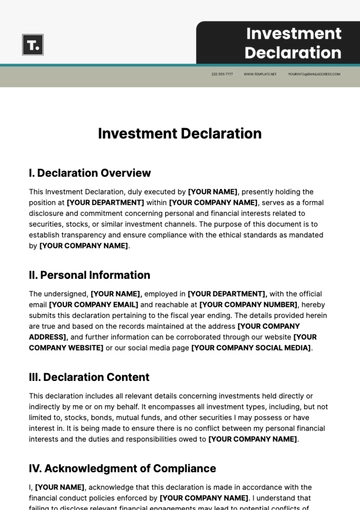Free Investment Thesis

Prepared by: [YOUR NAME]
[YOUR EMAIL]
The following investment thesis outlines a potential investment opportunity in the emerging electric vehicle (EV) market. This investment aims to capitalize on the growing demand for sustainable transportation, enhanced by government policies supporting clean energy initiatives. This document provides a comprehensive rationale for why investing in [YOUR COMPANY NAME] will generate significant returns while aligning with environmental, social, and governance (ESG) goals.
II. Investment Opportunity
[YOUR COMPANY NAME], founded in 2025, specializes in the development and production of next-generation electric vehicles designed to outperform existing models in efficiency, safety, and sustainability. With an expected market expansion of 15% annually over the next decade, this company represents an ideal investment opportunity for stakeholders looking to enter the rapidly growing electric vehicle sector.
The EV market is forecasted to grow from $250 billion in 2025 to over $800 billion by 2050, driven by technological advancements, increased consumer adoption, and government incentives. The growth of [YOUR COMPANY NAME] is supported by strategic partnerships with leading battery manufacturers and a strong pipeline of innovative models set to be launched in 2027.
III. Industry and Market Analysis
The electric vehicle industry is experiencing unprecedented growth as countries implement stricter emissions regulations and consumers increasingly prioritize sustainability. A recent market report from July 15, 2050, states that the global market for EVs is poised to surpass traditional internal combustion engine vehicles by 2035, driven by major automakers’ commitment to electrification.
Key market drivers include:
Government Policies: On March 1, 2050, the United States introduced a new federal tax incentive for EV buyers, which is expected to increase sales by 10% annually.
Technological Advancements: Battery energy density is improving by 7% year-over-year, contributing to longer range and faster charging times.
Consumer Trends: A recent survey on June 20, 2050, shows 60% of car buyers now prioritize environmental considerations in their purchasing decisions.
[YOUR COMPANY NAME] is well-positioned to take advantage of these trends with its cutting-edge battery technology and innovative vehicle designs.
IV. Financial Projections
The financial outlook for [YOUR COMPANY NAME] suggests robust growth and profitability in the coming years. Based on current performance and market trends, the company is projected to achieve the following key financial milestones:
Year | Revenue | EBITDA | Net Income | Growth Rate | Market Share (%) |
|---|---|---|---|---|---|
2025 | $150 million | $30 million | $10 million | 20% | 2% |
2026 | $200 million | $40 million | $15 million | 33% | 4% |
2027 | $300 million | $65 million | $25 million | 50% | 6% |
2030 | $500 million | $100 million | $50 million | 67% | 10% |
2035 | $900 million | $150 million | $75 million | 80% | 15% |
These projections reflect continued growth in sales, improved margins due to economies of scale, and expanded market presence.
V. Risk Analysis
While the electric vehicle sector offers significant opportunities, it is not without risks. [YOUR COMPANY NAME] faces potential challenges, including:
Supply Chain Disruptions: The global semiconductor shortage of 2052 could delay production timelines.
Regulatory Changes: Unexpected changes in government incentives or emissions regulations could impact profitability.
Competition: Increased competition from established automakers like Tesla and new entrants could slow market penetration.
These risks are mitigated through [YOUR COMPANY NAME]’s strategic focus on innovation, diversification of supply chains, and ongoing advocacy efforts with policymakers.
VI. Competitive Advantage
[YOUR COMPANY NAME]'s competitive advantage lies in its proprietary battery technology, which provides a 20% longer range compared to current industry standards. Additionally, its focus on sustainability with a fully carbon-neutral manufacturing process positions the company as a leader in the EV market.
Key differentiators include:
Exclusive Patents: The company holds exclusive patents for its high-efficiency battery technology, which could provide a long-term barrier to competition.
Sustainability: The company's carbon-neutral production methods and use of recycled materials enhance its ESG profile.
Brand Recognition: Strong brand recognition driven by successful product launches and positive consumer reception.
VII. Exit Strategy
For investors, the potential exit strategy for this investment would primarily involve:
Acquisition: Given the high level of interest from larger automakers in acquiring innovative EV companies, [YOUR COMPANY NAME] could be a target for acquisition by an industry giant.
Public Offering: A potential IPO in 2035 could provide significant returns, given the expected growth and profitability by that point.
Strategic Partnerships: Collaborations with other companies in the tech and automotive sectors could also create valuable exit opportunities.
VIII. Conclusion
Investing in [YOUR COMPANY NAME] offers a unique opportunity to capitalize on the rapidly expanding electric vehicle market, supported by favorable market conditions, strong financial performance, and a clear competitive advantage. With continued growth in both sales and market share, this investment aligns with long-term sustainability goals and offers an attractive return potential for investors.
For more information, please contact [YOUR NAME] at [YOUR EMAIL].
- 100% Customizable, free editor
- Access 1 Million+ Templates, photo’s & graphics
- Download or share as a template
- Click and replace photos, graphics, text, backgrounds
- Resize, crop, AI write & more
- Access advanced editor
The Investment Thesis Template on Template.net is a fully customizable and editable solution for investors looking to create comprehensive investment strategies. With the powerful AI Editor Tool, you can easily tailor the template to fit your unique needs, ensuring a professional and well-organized presentation every time. Get started today with this essential tool for financial success.





























